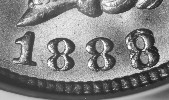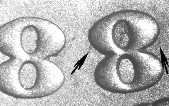Infopages
Is it an Overdate?
Is it an Overdate? by Dr. Tim Larson
As a Radiologist, I spend the day looking at X-ray, CT and MRI exams, wondering why things look the way they do. This same curiosity has carried over to my interest in coins.
While studying the 1888/887 S2 overdate recently, I couldn't make sense of what was supposed to be the underdate 7. I began to wonder if it was an 1888/887 overdate AND an 1888/1888 RPD or an 1888/1888 RPD with unusual markings to make it LOOK as though it's an 1888/887overdate. The non-controversial MPD will be ignored for discussion purposes.
I don't know the answer and would appreciate additional input and research from the society, especially from those with an interest and with access to high-grade specimens. No matter what the answer, it remains an intriguing variety. Consider the following.
1. The only reasonable way to explain the bulge in the east "waist" of the last eight is from another 8. It could not have resulted from a seven. It is evident on all three 8's, becoming progressively more prominent from the first to the third.
2. There are additional clues to the orientation and slant of the underdate that are not classically described. There is the tip of a serif from the underdate 1 along the left upright of the overdate 1. Additional portions of an underdate 8 are evident in the lower loops of the first and second overdate 8's and the upper loop of the third 8.
3. If one then makes an overlay of 1888(8over8.jpg) and superimposes it on all the underdate features mentioned in #2 above, the underdate slants considerably to the "south". The bottom of the last 8 would extend partially into the denticles. It would readily explain the bulges seen on each of the 8's, most prominent on the east "waist" of the third 8.

4. If one then superimposes the date 1887(8over7.jpg) in the same orientation of the underdate as described above, the seven would sit too low to account for the features classically described as being an overdate 8 over 7, especially the tips of the left serif. A simple 1888/887 overdate also would not explain the bulge along the "waist" seen on the last 8.
5. One might then say it's really an 1887/1888/1888. There are problems with this. First,
there are no features of a "first" 188 underdate in the correct orientation. Why would only the 7 boldly survive? Secondly, if the 1887 die was lapped, most of the 7 would have been destroyed. Thirdly, even if a portion of the 7 did remain, when the die was then struck with the first 1888 date, punched low, the top loop of the last eight would have further removed most of the "upright" of the 7 said to be currently visible in the upper loop of the last eight. Once it was recognized the date 1888 was too low, there would have been a SECOND lapping of the die with the date then repunched correctly. It is unlikely that ANY remnant of the 7 would have survived being lapped and repunched twice.
6. There are features of the overdate itself that appear suspect. What is described as the upright and corner of the underdate 7 in the upper loop of the last 8 has irregular, jagged margins, not smooth margins typical of a underdate. When other overdates in the series are studied (i.e.: 1858/7 S1, 1859/1859 S1, 1888/7 S1, etc.) the underdate is faithfully preserved. The underdate may be reduced in size or conspicuity (from lapping or repunching) but the fidelity of the margins are preserved. The surviving margins are smooth (not jagged). They are free of significant distortion or contour deformity. Why would the surviving upright be jagged?
7. The lower tip of the left serif of the purported seven is curvilinear and claw like. While the edge of the "claw" closest to the third 8 could be concave and still be the tip of a 7, the convex margin (rather than flat) towards the second 8 is suspect. This claw like mark IS readily accounted for by the upper left margin of the underdate 8 when an 1888/1888 overlay is studied.
8. If the date 1887 were punched using the orientation of the visible underdate, the left
serif of the 7 should project lower. If the underdate 7 position is as illustrated by the
overlay on page 10 of Longacres Ledger, Vol. 9.3, issue 41 (and one assumes the coin
IS an 1887/1888), why isn't the base of the 7 visible (as it is on the S1)? Why would
the lower tip of the 7 have been completely effaced with such complete preservation
of the upper portion? Using the orientation of the underdate, there should be a remnant
of the underdate 7 between the denticles and the base of the last 8 (assuming a simple
1887/1888 overdate).
9. The orientation of the purported upright of "7" in the upper loop of the final 8 is incorrect. When studying the overlays (as well as the S1 specimen for a reference) the alleged upright should slant from 7 o'clock to 1 o'clock in the upper loop. In the S2, it runs from 6 o'clock to 12 o'clock.

This being said, what DOES account for the markings superimposed in the upper loop of the final 8 (1882s2jpg)My hypothesis is that what has classically been described as "a upright of a 7" is a die crack. It's well known that metal within closed letters and numbers are subject to extra stress (ie within the letter B or numbers 6 and 8). They are basically "little islands" of metal in the die surrounded by the incuse portion of the letter/digit. They are prone to breaking and developing cracks or breaks. In addition, this area had already been stressed by the upper loop of the underdate 8, making it more prone to cracking. It could have just as easily developed in the first or second 8 of the date 1888. The linear orientation and irregular margins are typical for a die crack.In summary, what appears to be a 1888/1887 overdate is probably a 1888/1888 RPD. The lower left serif of the "7" is really a remnant of the upper left margin of the underdate 8. The upright of the underdate "7" is a die crack in the upper loop of the last 8.
If there is enough interest in the society, a project could be initiated to study specimens for evidence of progression of a die crack. Specimens could be sent to myself or Rick Snow.
Parenthetically, the images referred to in Longacres Ledger above should not be relied upon with regard to the underdate features. I don't believe the copper nickel example, being a harder alloy, is as well struck-up as the bronze coins are. In the absence of a specimen to study, refer to "Flying Eagle and Indian Cent Die Varieties" by Larry Steve and Kevin Flynn, 1995, page 144.
For the reasons stated above, I have serious doubts that the 1888/1887 S2 is an overdate. It is more likely an 1888/1888 RPD with a vertical die crack in the upper loop of the final 8. I am sure of one thing however. Given the presence of a RPD, MPD and die crack, it remains a very intriguing variety.
